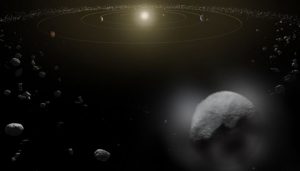Planetary scientists think the Sun may inadvertently create a transitory, tenuous atmosphere around the dwarf planet Ceres — and in an unexpected way.

ESA / ATG medialab
The dwarf planet 1 Ceres is the largest member of the asteroid belt. Since 1991, astronomers have occasionally detected an “exosphere” (an atmosphere so thin it’s not worthy of the name) of water molecules around the world. Water ice makes up a considerable fraction of Ceres’ makeup — in fact, we think there’s a global layer just 1 to 2 meters beneath the surface — but it was unclear what process was sending the molecules into space.
One explanation has been that sunlight is to blame. With the near-surface rocks containing 10% water by mass, surely the shine from our star could turn some of that ice into vapor, creating the exosphere. This sublimation process erodes comets as they near the Sun, for example. But detections of Ceres’ exosphere do not always coincide with the dwarf planet’s closest approaches to the Sun, ruling out sublimation as a solution.
Fortunately, astronomers have a spacecraft at Ceres: NASA’s Dawn orbiter. In June 2015, soon after its arrival, Dawn detected a short-lived exosphere around Ceres. It also detected a prequel: an uptick in energetic, charged particles arriving from the Sun, presaging the exosphere’s appearance.
Inspired, Michaela Villarreal (University of California, Los Angeles) and colleagues dove into archival data back to 1990 and discovered that, for the handful of times astronomers have observed an exosphere around Ceres, the wispy water cloud appeared after a burst of solar wind hit the dwarf planet. These speedy solar particles likely were accelerated by shock waves from coronal mass ejections (CMEs), which shooed the particles like a supersonic farmer herding chickens until they were swept up by the interplanetary-scale solar magnetic field, flying through space and whacking into Ceres.
Hitting the world’s surface, the solar wind’s high-speed particles would knock water molecules into space, creating an exosphere that lasts about a week. The team reports the result in the March 20th Astrophysical Journal Letters.
You can read more about the study in the Jet Propulsion Lab’s press release.
Are you ready for August's continent-spanning total solar eclipse? Find what you need in our comprehensive guide.
 0
0









Comments
You must be logged in to post a comment.